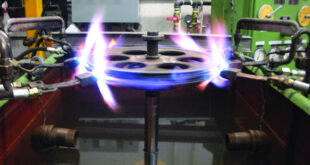A Comprehensive Overview, Process, and Benefits Introduction Flame hardening, also known as flame surface hardening or flame heating, is a heat treatment method used to increase the hardness and wear resistance of metal surfaces. It involves the localized heating of a metal component using a high-temperature flame, followed by rapid …
Read More »Different Types of Iron and Their Weldability
Different Types of Iron and Their Weldability Introduction Iron plays a pivotal role in a multitude of industries, serving as a fundamental building block for countless applications. From construction to manufacturing, transportation to infrastructure, the versatility of iron makes it an indispensable material. Understanding the weldability of different types of …
Read More »Knife-Line Attack in Stainless Steel
Knife-Line Attack in Stainless Steel Knife-Line Attack is a form of corrosion that can weaken Stainless Steel structures and components. It is characterized by the development of thin cracks along the grain boundaries of the material. These cracks can significantly reduce the strength of the steel and, if not controlled, …
Read More »What Is Heat Affected Zone (HAZ)?
What Is Heat Affected Zone (HAZ)? Introduction Definition of the Heat Affected Zone (HAZ) The Heat Affected Zone (HAZ) refers to the region of a material that undergoes significant changes in its microstructure and mechanical properties due to the heat generated during welding or heat treatment processes. When heat is …
Read More »What is Damascus Steel ?
What Is Damascus Steel? Introduction Damascus Steel is a forging technique that involves the careful manipulation of the steel’s composition and the repeated folding and welding of the layers to produce a distinct patterned appearance. Historical significance and popularity of Damascus steel Damascus steel holds a rich historical significance and …
Read More »Optimization of Welding Process
Optimization of Welding Process Introduction Welding process optimization refers to the systematic improvement of welding operations to enhance productivity, quality, efficiency, and cost-effectiveness. It involves analyzing various factors, such as material properties, joint design, welding parameters, and environmental conditions, to achieve optimal welding results. Optimizing welding processes is crucial for …
Read More »What is Pattern Welding?
What is Pattern Welding? Introduction Introduction to Pattern Welding Pattern welding, also known as Damascus steel or Damascene technique, is a traditional method of forging metals to create intricate patterns and designs. It involves the joining and layering of different types of metals to produce a visually appealing and structurally …
Read More »The Challenges of Metal Identification in Welding: How to Overcome Them
The Challenges of Metal Identification in Welding: How to Overcome Them Introduction Metal identification is a crucial aspect of welding that is often overlooked, yet it is a fundamental step in ensuring the success of any welding project. Identifying the type of metal being welded is essential to determine the …
Read More » Welding of Welders All about Welding and Welders
Welding of Welders All about Welding and Welders







